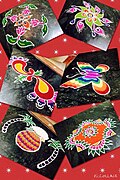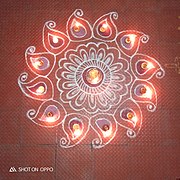Kolam


Kolam (Tamil: கோலம், Malayalam: കോലം, Kannada: ರಂಗೋಲೆ), also known as Muggu (Telugu: ముగ్గు), Tarai Alangaram (Tamil: தரை அலங்காரம்) and Rangoli (Kannada: ರಂಗೋಲೆ) is a form of traditional decorative art that is drawn by using rice flour as per age-old conventions. It is also drawn using white stone powder, chalk or chalk powder, often along with natural or synthetic color powders.[citation needed] Its origin belongs to the ancient Tamil Nadu known as Tamilakam and has since spread to the other southern Indian states of Karnataka, Telangana, Andhra Pradesh, and Kerala. It can be found in some parts of Goa and Maharashtra. Since the Tamil diaspora is worldwide, the practice of kolam is found around the world, including in Sri Lanka, Singapore, Malaysia, Indonesia, Thailand and a few other Asian countries.[citation needed] A kolam or muggu is a geometrical line drawing composed of straight lines, curves and loops, drawn around a grid pattern of dots. It is widely practised by female family members in front of their house entrance, although men and boys also practice this tradition.[1] The similar regional versions of kolam with their own distinctive forms are known by different names in India: raangolee in Maharashtra, aripan in Mithila, alpona in West Bengal and hase and rangole in Kannada in Karnataka.[2] More complex kolams are drawn and colors are often added during festival days, holiday occasions and special events. [citation needed]
Practice and belief
[edit]
Kolams or muggulu are thought to bring prosperity to homes.[citation needed] In millions of households in Tamil Nadu, Telangana and Andhra Pradesh, women draw kolams in front of their home entrance every day at the break of dawn. Traditionally kolams are drawn on the flat surface of the ground with white rice flour.[citation needed] The drawings get walked on throughout the day, washed out in the rain, or blown around in the wind; new ones are made the next day. Each morning before sunrise, the front entrance of the house, or wherever the kolam may be drawn, is swept clean, sprinkled with water, thereby making for a flat surface. The kolams are generally drawn while the surface is still damp so the design will hold better.[citation needed] Instead of rice flour (Tamil: கோலமாவு/Telugu: బియ్యం పిండి), white stone powder is occasionally used for creating Kolam; cow dung is also used to wax the floors. In some cultures, cow dung is believed to have antiseptic properties and hence provides a literal threshold of protection for the home. It also provides contrast with the white powder.[3]
Decoration is not the main purpose of a kolam. In the olden days, kolams or muggulu were drawn in coarse rice flour so the ants would not have to walk too far or too long for a meal.[citation needed] The rice powder also invites birds and other small creatures to eat it. It is a sign of invitation to welcome all into the home, not the least of whom is Lakshmi, the goddess of prosperity and wealth.[citation needed] The patterns range from geometric and mathematical line drawings around a matrix of dots to free-form artwork and closed shapes. Folklore has evolved to mandate that the lines must be completed to symbolically prevent evil spirits from entering the inside of the shapes. Thus, they are prevented from entering the inside of the home.[citation needed]
It used to be a matter of pride to be able to draw large complicated patterns without lifting the hand off the floor or standing up in between. The month of Mārgaḻi/Margasira was eagerly awaited by young women, who would then showcase their skills by covering the entire width of the road with one big kolam.[4]
In the kolam patterns, many designs are derived from magical motifs and abstract designs blended with philosophical and religious motifs which have been mingled together.[5] Motifs may include fish, birds, and other animal images to symbolise the unity of man and beast. The sun, moon and other zodiac symbols are also used.[6] A downward-pointing triangle represents woman; an upward-pointing triangle represents man. A circle represents nature while a square represents culture.[7] A lotus represents the womb. A pentagram represents Venus and the five elements.
The ritual kolam patterns created for special occasions such as weddings often stretch down the street. Many of these created patterns have been passed on from generation to generation, from mothers to daughters.[citation needed]
Text messages like the word welcome (Tamil: நல்வரவு/స్వాగతం) or a seasonal phrase, happy new year, can also be used in kolam/muggu. Volunteering to draw the kolam at the temple is sometimes done when a devotee's wishes are fulfilled. The art of kolam designs has found its way into the future through social networking sites like Facebook. Many kolam/muggu artists have large fan followings online and are playing a role in making the kolam art form a key part of South India's contemporary art scene.[7]
Variants
[edit]
For special occasions limestone and red brick powder for contrast are also used. Though kolams[8] are usually made with dry rice flour (kolapodi), for longevity, dilute rice paste or even paints are also used. Modern interpretations have accommodated chalk, and more recently vinyl stickers.[citation needed]
Though not as flamboyant as its other Indian contemporary, rangoli, which is extremely colourful, a South Indian Kolam is all about symmetry, precision, and complexity.[9]
Patterns
[edit]
- a pattern in which a stroke (neli, kambi, sikku in Tamil) runs once around each dot (pulli), and returns to the beginning point as a mostly geometrical figure. The stroke is called neli from a snakey line.[clarification needed] The stroke has a knot-like (sikku) structure.[citation needed]
- a pattern using only part of the dot grid. If that is the case, the same pattern or a different pattern fills/uses up the remaining dot grids. Most of the times, these patterns together end up becoming a complex pattern.[citation needed]
- a pattern in which a stroke runs around each dot incompletely, but open.
- a pattern in which strokes (kodu/kotto) are connected between the dots. Sometimes they represent kinds of objects, flowers, or animals.
- a pattern in which dots are set in a radial arrangement, called lotus.
- a pattern which is drawn freestyle and mostly coloured.[citation needed]
Research
[edit]- The mathematical properties of kolams are studied and replicated in computer science.[9]Algorithms have been developed for generating kolam designs with different patterns.[citation needed]
- Algorithms for drawing kolams are used in the development of picture-drawing computer software.[10]
- Kolams are a topic of research in computational anthropology.[11]
- As kolams have a strong relationship with contemporary art and art history, they are used in the art and media fields.[12]
- Kolams are also used to simplify the representation of complex protein structures for easy understanding.[13]

Gallery
[edit]-
Coloured kolam in Attur
-
Pongal kolam from Chennai, India
-
Kolam at Andayil Temple, Pudunagaram
-
Kolam outside a house in Tamil Nadu, India
-
Kolam in Kanyakumari District of Tamil Nadu
See also
[edit]References
[edit]- ^ Dr.Gift Siromoney. "KOLAM". Chennai Mathematical Institute. Retrieved 12 January 2012.
- ^ "Kolams". Auroville. Archived from the original on 30 December 2011. Retrieved 12 January 2012.
- ^ "Traditional customs and practices - Kolams". Indian Heritage. Retrieved 13 January 2012.
- ^ "'Kolam' draws huge crowd". The Hindu. Trichy, India. 7 January 2010. Archived from the original on 10 January 2010.
- ^ Dr.Gift Siromoney. "Kolam-South Indian kolam patterns". Chennai Mathematical Institute. Retrieved 13 January 2012.
- ^ "Pongal festival - Kolam design ideas". India Today. India. 12 January 2012.
- ^ a b "Between the Rangoli lines". Devdutt Pattanaik. 29 November 2009.
- ^ Gamadia, Roweena. "Rangoli Kolam- Designs and Samples of Rangoli Kolam". Rangoli Design. Archived from the original on 15 July 2014. Retrieved 20 September 2014.
- ^ a b Marcia Ascher (January 2002). "The Kolam tradition". American Scientist. Archived from the original on 30 September 2015. Retrieved 25 January 2012.
- ^ "Kolam figures" (PDF). Mathematics department, Iowa State University. Retrieved 25 January 2012.
- ^ "The Kolam project". Center for Undergraduate Research, University of Maine. Archived from the original on 7 March 2012. Retrieved 25 January 2012.
- ^ Adam Atkinson (September 2011). "The Mystery of Kolam". Northampton Community College. Archived from the original on 13 October 2012. Retrieved 25 January 2012.
- ^ Protein Kolam
External links
[edit] Media related to Kolam at Wikimedia Commons
Media related to Kolam at Wikimedia Commons





